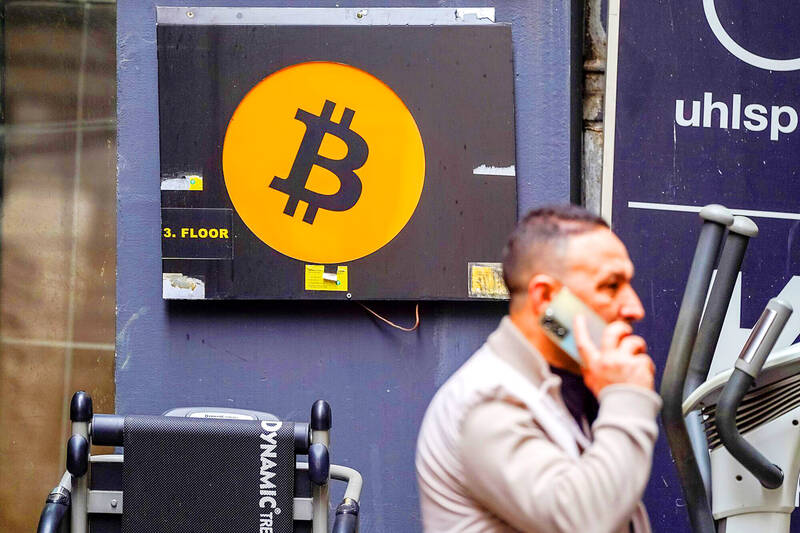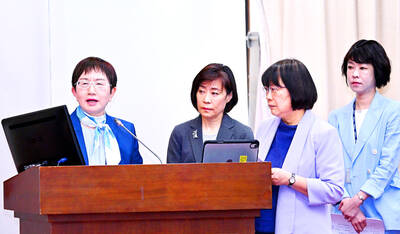About 6,000 older bitcoin mining machines in the US are to soon be idled and sent to a warehouse in Colorado Springs, where they are to be refreshed and resold to buyers overseas looking to profit from mining in lower-cost environments.
Wholesaler SunnySide Digital Inc operates the 3,251 square meter facility taking in the equipment from a mining client. The outdated machines are among several hundred thousand it expects to receive and refurbish around a major quadrennial update in the bitcoin blockchain.
Known as the “halving,” the event in late next month would slash the reward that is the main revenue stream for miners, who would try to lessen the impact by upgrading to the latest and most efficient technology.

Photo: Bloomberg
With electricity the biggest expense, mining companies including publicly traded giants Marathon Digital Holdings Inc and Riot Platforms Inc need to lower usage costs to maintain a positive margin. Their older computers might still bring a profit, just not likely in the US.
“It’s a natural migration” with buyers of the old machines operating in parts of the world where power is the cheapest, said SunnySide Digital chief executive officer Taras Kulyk, who has resold US computers to miners in countries such as Ethiopia, Tanzania, Paraguay and Uruguay.
“This is accelerated by the halving,” he added.
About 600,000 S19 series computers, which account for a majority of machines currently in use, are moving out of the US mostly to Africa and South America, said Ethan Vera, chief operating officer at crypto-mining services and logistics provider Luxor Technology Corp in Seattle.
In bitcoin mining, specialized machines are used to validate transactions on the blockchain and earn operators a fixed token reward. Anonymous bitcoin creator Satoshi Nakamoto baked in the once-every-four-years halving to maintain the hard cap of 21 million tokens.
Next month’s event is the fourth since 2012 and the reward is to drop to 3.125 bitcoin from 6.25 now.
Bitcoin has surged 50 percent this year to about US$63,500, though it is down from a record high of US$73,798 reached on March 14 this year. Bringing more efficient machines online has become more urgent with the halving just weeks away, as continued use of older equipment could mean electricity costs would be close to or exceed mining revenue.
There are miners in the US opting not to sell their hardware and instead transfer the equipment to regions with lower electricity costs and third-party data centers. Nuo Xu (徐諾), who has two sites in Texas, is traveling this month to Ethiopia, Nigeria and a few other countries to scope out locations for about 6,000 older computers.
“There are more risks for my machines in Africa but I have to move them there,” he said. “Cheaper electricity outside the US means it will take a much shorter time to recover the overhead costs,” with labor and building materials also much less expensive, he added.
However, not all US-based equipment leaves the country. That process could be tougher for publicly traded companies because they have to take risk-averse shareholders into account. There is also some hesitation to relocate machines abroad due to transportation costs, breakage and security concerns.
Still, miners have been prepping for the halving for years and are spending big bucks to replace their older hardware. The 13 major public bitcoin-mining companies, including Riot Platforms and CleanSpark Inc, have placed orders for more than US$1 billion worth of machines since February last year, crypto-mining researcher TheMinerMag said.
Five of the biggest miners raised more than US$2.7 billion from selling shares in the two years ended in December last year.
Since the start of this year, those same miners have raked in an additional US$840 million, the researcher said.

‘SWASTICAR’: Tesla CEO Elon Musk’s close association with Donald Trump has prompted opponents to brand him a ‘Nazi’ and resulted in a dramatic drop in sales Demonstrators descended on Tesla Inc dealerships across the US, and in Europe and Canada on Saturday to protest company chief Elon Musk, who has amassed extraordinary power as a top adviser to US President Donald Trump. Waving signs with messages such as “Musk is stealing our money” and “Reclaim our country,” the protests largely took place peacefully following fiery episodes of vandalism on Tesla vehicles, dealerships and other facilities in recent weeks that US officials have denounced as terrorism. Hundreds rallied on Saturday outside the Tesla dealership in Manhattan. Some blasted Musk, the world’s richest man, while others demanded the shuttering of his

ADVERSARIES: The new list includes 11 entities in China and one in Taiwan, which is a local branch of Chinese cloud computing firm Inspur Group The US added dozens of entities to a trade blacklist on Tuesday, the US Department of Commerce said, in part to disrupt Beijing’s artificial intelligence (AI) and advanced computing capabilities. The action affects 80 entities from countries including China, the United Arab Emirates and Iran, with the commerce department citing their “activities contrary to US national security and foreign policy.” Those added to the “entity list” are restricted from obtaining US items and technologies without government authorization. “We will not allow adversaries to exploit American technology to bolster their own militaries and threaten American lives,” US Secretary of Commerce Howard Lutnick said. The entities

Minister of Finance Chuang Tsui-yun (莊翠雲) yesterday told lawmakers that she “would not speculate,” but a “response plan” has been prepared in case Taiwan is targeted by US President Donald Trump’s reciprocal tariffs, which are to be announced on Wednesday next week. The Trump administration, including US Secretary of the Treasury Scott Bessent, has said that much of the proposed reciprocal tariffs would focus on the 15 countries that have the highest trade surpluses with the US. Bessent has referred to those countries as the “dirty 15,” but has not named them. Last year, Taiwan’s US$73.9 billion trade surplus with the US

Prices of gasoline and diesel products at domestic gas stations are to fall NT$0.2 and NT$0.1 per liter respectively this week, even though international crude oil prices rose last week, CPC Corp, Taiwan (台灣中油) and Formosa Petrochemical Corp (台塑石化) said yesterday. International crude oil prices continued rising last week, as the US Energy Information Administration reported a larger-than-expected drop in US commercial crude oil inventories, CPC said in a statement. Based on the company’s floating oil price formula, the cost of crude oil rose 2.38 percent last week from a week earlier, it said. News that US President Donald Trump plans a “secondary